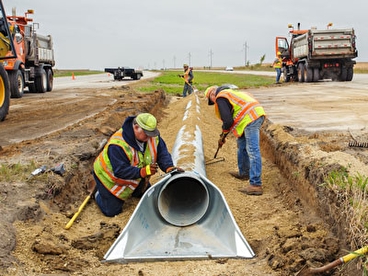Reputable Pad Construction for Your Task Needs
Reputable Pad Construction for Your Task Needs
Blog Article
Mastering Culvert Installation: Boost Your Land Water Drainage Initiatives
Reliable land drain is an essential component of successful agricultural and framework tasks. Culverts play a substantial duty in managing water flow and stopping erosion, making their appropriate installment necessary. From picking the ideal materials to executing ideal methods, understanding culvert setup can significantly boost the efficiency and long life of your land drainage system. By comprehending the complexities of culvert setup, you can optimize your water drainage initiatives and make sure lasting land usage practices.
Importance of Culvert Installation
Ensuring proper culvert setup is paramount for maintaining effective land water drainage systems. Culverts play a crucial role in taking care of water flow, protecting against disintegration, and maintaining the structural stability of roads, bridges, and other framework. Proper installment of culverts aids to direct water far from roadways and structures, lowering the risk of flooding and water damage. Additionally, well-installed culverts help in protecting against sediment buildup, which can result in blockages and lowered water circulation.
Proper Sizing and Positioning

Appropriate placement of culverts is equally crucial. Culverts need to be positioned at the most affordable point of the area needing drain to make sure efficient water circulation. Additionally, they should be set up vertical to the all-natural slope of the land to stop clogs and permit smooth water passage. Strategic placement can assist protect against waterlogging, soil erosion, and roadway damages, guaranteeing the longevity and performance of the land water drainage system.
Material Option Tips
Picking the best products is paramount in making certain the sturdiness and functionality of culverts for reliable land water drainage systems. When picking products for culvert installment, it is critical to take into consideration aspects such as the water circulation price, soil structure, and ecological problems of the website.
Among the most typical products made use of for culverts is corrugated steel (Tree removal). Corrugated metal culverts are resilient, economical, and easy to set up. They are appropriate for areas with high water flow rates and can withstand hefty lots. One more popular option is concrete culverts, which use excellent stamina and durability. Concrete culverts are ideal for areas vulnerable to rust or when a longer solution life is wanted.
For eco sensitive locations, plastic culverts may be chosen. Furthermore, in locations where all-natural aesthetic appeals are important, materials like rock or wood can be utilized to construct Road construction culverts that mix flawlessly into the environments.
Installment Techniques and Ideal Practices
Given the critical importance of material choice in ensuring the performance and long life of culverts, the setup strategies and ideal methods play a crucial function in the general success of land drainage systems. Correct installment is crucial to avoiding issues such as leaks, breaks down, or blockages that can endanger the effectiveness of the culvert.

Throughout installment, treatment needs to be taken to straighten the culvert correctly and offer correct support to avoid deformation. Backfilling needs to be done progressively and compressed in layers to stay clear of spaces and negotiation. Correct compaction is essential to prevent changing or sinking of the culvert over time.

Upkeep and Long-Term Treatment
Executing an extensive upkeep plan is important for guaranteeing the long life and reliable efficiency of culverts in land drain systems. Cleaning debris such as leaves, branches, and debris is important to stop obstructing and keep the circulation capability of the culvert.
Furthermore, attending to any kind of issues promptly and making needed repair services or replacements can aid prevent expensive damages in the long run. Regular maintenance jobs might consist of cleansing, fixing joints, reinforcing inlet and outlet structures, and guaranteeing correct incline and placement of the culvert. Maintaining thorough documents of maintenance tasks, inspections, and repair services is crucial for tracking the problem of the culvert with time and preparing future maintenance requirements. By remaining proactive and implementing a complete upkeep strategy, land drain systems can operate properly and efficiently for several years ahead.
Conclusion
Finally, mastering culvert setup is vital for efficient land drain. Proper sizing, positioning, product choice, installment techniques, and upkeep are crucial aspects to think about. By complying with best practices and implementing long-lasting care strategies, landowners can boost their water drainage efforts and ensure the longevity and capability of their culverts. It is vital to prioritize these aspects to stop water damage, erosion, and various other expensive concerns on the residential property.
Report this page